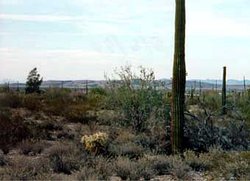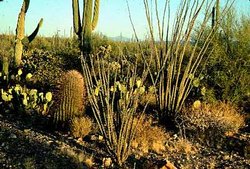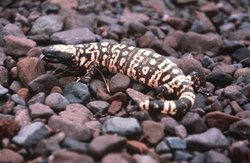Sonoran desert (Agricultural & Resource Economics)
Contents
Sonoran desert
| Topics: |
The contents of this page have been subsumed into the more comprehensive article: Sonoran Desert
The Sonoran Desert exhibits the greatest diversity of plant species of any desert worldwide. This unique ecoregion constitutes a large area located in the southwestern USA and northern Mexico. With such a harsh climate, there are a surprising number of mammal, reptile and bird taxa, as well as a number of amphibian species, including the Tiger Salamander (Ambystoma tigrinum). Cattle overgrazing and urban development are the chief ecological threats to the Sonoran Desert.
Location and general Depiction
The Sonoran Desert in the USA reaches from extreme southeastern California across the western two-thirds of southern Arizona. In Mexico, the desert stretches south to encompass much of the state of Sonora, as well as the eastern shore of Baja California to the town of Loreto. The Colorado River passes through this ecoregion as do the Yaqui, Salt, Verde and Gila Rivers.
The highest area in the western part of the ecoregion, which reaches 1206 meters in elevation, was formed when intense volcanic activity adjacent to a portion of the Gulf of California formed a lava spill and a variety of cinder cones surrounding the Pinacate area. The rest of the western section is composed of plateaus and sand dunes reaching no more than 200 m above sea level. The south-central part of the Mexican state of Sonora is dominated by the foothills of the western Sierra Madre Occidental. These mountains reach elevations between 1000 and 2000 m, resulting from a system of faults and generalized volcanic activity during the Cenozoic era. Soils are sandy and alkaline in the dunes, but toward the Pinacate and mountainous regions they are made of igneous or metamorphic material.
The climate of the Sonoran Desert ecoregion varies slightly due to its large areal extent. In the Arizona upland section, conditions are more mesic, with bi-seasonal rainfall between 100-300 millimeters annually. Climate is subtropical dry near the Gulf of California. Near the Colorado River Valley and all remaining parts of the ecoregion temperatures are high year round with infrequent, irregular rainfall creating an arid dry climate. The Desierto de Altar, in the western Sonoran ecoregion, is one of the driest areas in North America, with periods of drought that can last for 30 months. In general, the ecoregion is quite arid, receiving less than 90 mm of annual rainfall.
Creosote (Larrea divaricata) and White Bursage (Ambrosia dumosa) vegetation characterize the lower Colorado River Valley section. The Arizona upland section to the north and east is more mesic, resulting in greater species diversity and richness. Lower elevation areas are dominated by dense communities of creosote and white bursage, but on slopes and higher portions of bajadas, subtrees such as palo verde (Cercidium floridum, C. microphyllum) and Ironwood (Olneya tesota), saguaros (Carnegiea gigantia), and other tall cacti are abundant. La gobernadora (Larrea tridentata) and White Bursage (Ambrosia dumosa) form the scrub that dominates the northwest part of the Sonoran Desert. It grows on deep, sandy soils] in the flatlands. Where the dunes allow for slight inclination of the slope, species of mesquite (Prosopis), Cercidium, Ironwood (Olneya tesota), Candalia, Lycium, choya (Opuntia), Fouquieria, jécota (Hymenoclea) and Acacia are favored. The coastal plains of Sonora are composed of an almost pure Larrea scrub. Away from the Gulf influence in the area surrounding the Pinacate Encelia farinosa, Larrea tridentata, and cacti species such as Olneya, Cercidium, Prosopis, and Fouquieria again dominate the desert. Epiphytes are very scarce but not absent, as are moss and lichens.
Biodiversity Features
The Sonoran Desert has the greatest diversity of vegetative growth of any desert in the world. 560 plant species grow in the extremely harsh conditions of drought and heat, and interact in a variety of ecological relationships that add to the complexity of the community. More than 160 plant species, including six threatened succulents, depend upon legumes such as ironwood and mesquite for their regeneration in the Sonoran Desert.
The saguaro cactus (Cereus giganteus) is by far the most recognizable Sonoran Desert species. The largest of all cacti, it is only one of many cactus species found in this ecoregion. Cholla cactus (Opuntia fulgida), organ pipe (Lemaireocereus thurderi), silver dollar cactus (Opuntis chlorotica), and jojoba (Simmondsia chinensis) are a few of the numerous cacti in this ecoregion. The Sonoran coastal plain area houses the palo fierro or ironwood (Olneya tesota) which is the oldest desert tree. It has also been demonstrated that ironwood (Olneya tesota) and palo verde (Cercidium floridum) nursing relationships promote diversification and increase richness of other plants in arid ecosystems. Another remarkable plant found in the Sonora desert is the ocotillo (Fouquieria splendens), which may remain leafless during the coldest months of winter but experiences five or six leafy periods throughout the year. The brilliant red conical flowers are often triggered by the first cool-season rain in the spring, flowering within as few as 48 hours and attracting hummingbirds and other nectar feeders.
Mammals
Many wildlife species, such as Sonoran Pronghorn Antelope (Antilocapra sonoriensis EN), desert Bighorn Sheep (Ovis canadensis) and the endemic Bailey's pocket mouse (Perognathus baileyi) use ironwood, cacti species and other vegetation as both shelter from the harsh climate as well as a water supply. Other mammals include predators such as Puma (Felis concolor), Coyote (Canis latrans) and prey such as black-tailed jackrabbits (Lepus californicus), and round-tailed ground squirrels (Spermophilus tereticaudus). Other mammals able to withstand the extreme desert climate of this ecoregion include California leaf-nosed bat (Macrotus californicus) and ring-tailed cat (Bassasiscus astutus).
Avian species
The Sonoran desert is recognized as an exceptional birding area within the USA. Forty-one percent (261 of 622) of all terrestrial bird species found in the USA can be seen here during some part of the year. The Sonoran desert, together with its eastern neighbor the Chihuahuan Desert, is the richest area in in the United States for birds, particularly hummingbirds. Among the bird species found here are the saguaro-inhabiting Costa's Hummingbird (Calypte costae), black-tailed gnatcatcher (Polioptila melanura), Phainopepla (Phainopepla nitens) and Gila woodpecker (Melanerpes uropygualis). Perhaps the most well-known Sonoran bird is the Greater Roadrunner (Geococcyx californianus), distinguished by its preference for running rather than flying, as it hunts scorpions, tarantulas, rattlesnakes, lizards, and other small prey. The Sonoran desert harbors two endemic bird species, the highest level of bird endemism in the USA. The rufous-winged sparrow (Aimophila carpalis) is fairly common in most parts of the Sonoran, but only along the central portion of the Arizona-Mexico border, seen in desert grass mixed with brush. Rare in extreme southern Arizona along the Mexican border, the five-striped sparrow (Amphispiza quinquestriata) lives predominantly in canyons on hillsides and slopes among tall, dense shrubs.
Reptiles
Fifty-eight species of [[reptile]s], including six species of rattlesnake, are found in the U.S. portion of this rich desert. The threatened desert tortoise (Gopherus agassizii) makes its home in burrows and frequents desert oases, washes, and riverbanks throughout the Sonoran. Perfectly camouflaged for life in the Sonoran, the giant Gila Monster (Heloderma suspectum) is one of several lizards inhabiting this region.
Amphibians
The widespread Tiger Salamander (Ambystoma tigrinum), the world's largest land-dwelling salamander, is able to survive in the Sonoran by the fossorial habit of burrowing underground during the dry season and emerging during wet times. The tiger salamander is one of several [[amphibian]s] able to live in this arid ecoregion.
Current Status
 Ajo, Arizona, USA. (Photograph by The GLOBE Program)
Ajo, Arizona, USA. (Photograph by The GLOBE Program) About 60% of habitat in the US alone have been altered by agriculture, grazing, excessive groundwater pumping, and urbanization. Riparian woodland [[habitat]s] have suffered, by far, the worst and are now one of the rarest habitats in North America. Residential development on bajadas is eliminating the habitat of bajada-dependent species such as cholla cacti (Opuntia) and columnar cacti such as Saguaro. Rocky habitat areas preferred by gila monsters and bighorn sheep are prime real estate for development. The last population of Sonoran pronghorn is confined to the Cabeza area in southern Arizona, isolated by lack of connectivity with other habitat areas.
The dry, inhospitable nature of the Sonoran Desert has favored the preservation of large areas with original vegetation. Four protected areas have been established in the Mexican Sonoran Desert in the last two decades, but they occupy less than 5% (9540 square kilometers) of the original desert area. In the United States approximately 17% of the Sonoran Desert is protected. The Cabeza Prieta National Wildlife Refuge and Organ Pipe National Monument Biosphere Reserve, both in Arizona, and the four protected areas in the Mexican part of the Sonoran Desert ecoregion form the second largest protected area of xeric scrub in North America. Lack of connectivity between all protected areas within and across borders also remains a serious problem. Other areas that include wildlife refuges, national monuments and/or military installations are located in the Kofa Mountains, Lower Colorado River, Arrastra Mountains, Chuchwilla Mountains, Eagletail Mountains, and Turtle Mountain. In addition, there are large areas of intact habitat within the Tohono O'odham Indian Reservation.
Ecological threats
Threats to the ecoregion include cattle grazing, agriculture, excessive groundwater pumping, urbanization, and mineral extraction. The urban and suburban areas of Phoenix and Tucson in the USA continue to expand rapidly. This in turn is pushing agricultural operations further into the desert and along riparian areas such as the Gila River, with tremendous impacts on wildlife habitat. Riparian habitats are threatened by trampling, grazing and fouling by domestic livestock; water diversion and dam building; conversion for agriculture; and alien species such as the Tamarisk tree (Tamarix chinensis). Furthermore, the introduction of invasive animal and plant species could displace native fauna and flora through direct competition.
The introduction of buffel grass (Cechrus ciliaris), resulting in cattle overgrazing, has been particularly destructive to desert grassland and cryptic crust soils; Buffel Grass accumulates, forming combustible litter that causes the complete burning of ironwood and other plants. As a result, arid grasslands replace the xeric scrub, thereby lowering or preventing the recruitment of perennials. If this practice remains uncontrolled, the landscape of the Sonoran Desert may change and biodiversity may be lost. Another significant threat to the region is the abundant, illegal collection of plant and animal species of high biological value, and the uncontrolled hunting of endangered species such as mule deer, pronghorn antelope, and mountain sheep. Tourism activities in the region have become extensive, bringing increased danger of pollution and disturbance of flora. Long-term threats to the area include the extension of highways and the establishment of an industrial plant for toxic waste treatment, which could pollute the environment.
Further Reading
- Bailey, R.G. 1994. Ecological classification for the United States.
- Búrquez, A., and M. A. Quintana. 1994. Islands of diversity: Ironwood ecology and the richness of perennials in a Sonoran Desert biological reserve.
- Challenger, A. 1998. Utilización y conservación de los ecosistemas terrestres de México. Pasado, presente y futuro. ISBN: 9709000020
- CONABIO Workshop, 17-16 September, 1996. Informe de Resultados del Taller de Ecoregionalización para la Conservación de México.
- CONABIO Workshop, Mexico, D.F., November 1997. Ecological and Biogeographical Regionalization of Mexico.
- Cooperrider, A. Y., and D. S. Wilcove. 1995. Defending the Desert. Conserving Biodiversity on BLM Lands in the Southwest. ASIN: B0006QCVK0
- Ezcurra, E., and V. Rodrigues. 1986. Rainfall patterns in the Gran Desierto, Sonora, México. Journal of Arid Environments.
- Ferrusquía-Villafranca, I. 1993. Geología de México: Una Sinopsis.
- INE-SEMARNAP. 1995. Programa de Manejo. Reserva de la Biósfera de El Pinacate y Gran Desierto de Altar.
- Küchler, A. 1975. Vegetation maps of North America. Lawrence: University of Kansas Libraries.
- MacMahon, J.A. 1988. Warm deserts. North American terrestrial vegetation. Cambridge University Press: Cambridge, England.
- Mancilla-Macial, R. B. 1988. Selección de semillas de plantas anuales y estrategia forrajera de la hormiga Messor pergandei (Mayr) en el desierto central de Baja California, México. Simposio sobre diversidad biológica de México (Oaxtepec, Morelos, 3-7 Octubre 1988). Resúmenes de los carteles. Instituto de Biología, UNAM, México. Pp. 11-12.
- McNab, W. H., and P. E. Avers (compilers). 1994. Ecological subregions of the United States: Section descrptions. WO-WSA-5. USDA Forest Service, Ecosystem Management, Washington, D.C.
- Noss, R. F., and R. L. Peters. 1995. Endangered ecosystems of the United States: A status report and plan for action. Defenders of Wildlife, Washington D.C
- Phillips, S.J. and P.W. Comus (eds.) 2000. A Natural History of the Sonoran Desert. Arizona-Sonora Desert Museum Press, Tucson, and University of California Press, Berkeley.
- Omerinick, J.M. 1995. Ecoregions: A framework for managing ecosystems. George Wright Forum 12(1):35-51.
- Rzedowski, J. 1962. Contribuciones a la fitogeografía florística e histórica de México.
- Rzedowski, J. 1988. La Vegetación de México. México: Editorial Limusa.
- Tewksbury, J. J., and C. A. Petrovich. 1994. The influences of ironwood as a habitat modifier species: A case study on the Sonoran Desert coast of the Sea of Cortez.
- Turner, R. M., J. E. Bowers, and T. L. Burgess. 1995. Sonoran Desert plants: An ecological atlas. University of Arizona Press, Tuscon. ISBN: 0816525196
| Disclaimer: This article contains some information that was originally published by the World Wildlife Fund. Topic editors and authors for the Encyclopedia of Earth have edited its content and added new information. The use of information from the World Wildlife Fund should not be construed as support for or endorsement by that organization for any new information added by EoE personnel, or for any editing of the original content. |

